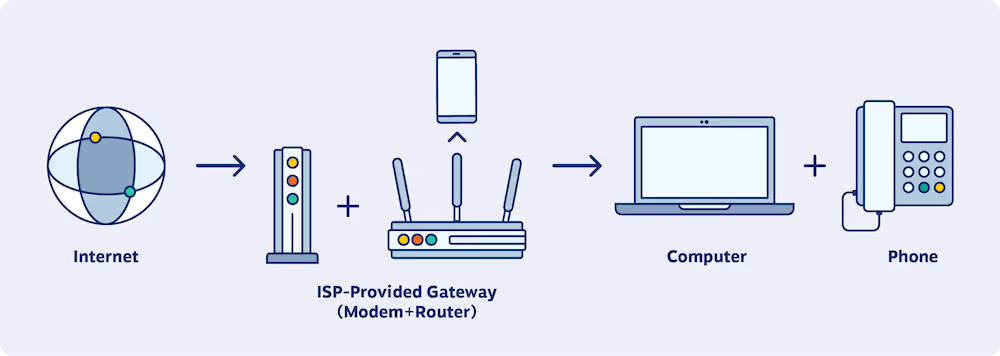Network Jitter: How to Test and Fix It | VoIP Phone Systems
Network Jitter: How to Test and Fix It | VoIP Phone Systems

When you’re using a VoIP service, you’re essentially making calls over an Internet data line instead of a traditional telephone line. Therefore, you’re bound to occasionally encounter the same type of issues with connectivity, latency, and other glitches when you’re taking and making calls on these platforms. Fortunately, for all the different problems out there, there are just as many solutions.
We suggest checking with your VoIP provider first, of course, because they’re the most likely resource to help you find the right solution for whatever issues you are having. However, we also like to provide a third-party perspective of how to fix things so that you understand all of your options. It’s also helpful for those whose providers don’t really offer much in the way of support or fixing small issues like network jitter or audio issues.
In this guide, we’ll cover the basics of network jitter on VoIP systems, how to troubleshoot the issue, and what solutions will be most effective. First, let’s talk more about why it happens.
What causes network jitter?
As mentioned, VoIP systems are connected via Internet data cables. Therefore, they’re subject to data interruptions, latency issues, and other connectivity problems, just like any Internet application.
To make a successful call, data packets need to be transmitted from the caller to the recipient. Since the packets take different paths, they may reach the destination at different times. This can result in what is known as network jitter. Because the packets of data are delivered irregularly, the missing or inconsistent data can lead to low call quality issues, including jitter.
Jitter is just an industry term used to describe any audio issues related to missing, jumbled, or echoing audio as the call is taking place. When the packets aren’t delivered at the same time, the audio can get discombobulated and lead to several different quality issues. If there’s a slight bit of jitter (30 milliseconds or less), that’s pretty standard and acceptable.
Anything more than that, however, can affect call quality and communications. So naturally, if you need to resolve jitter issues, the first consideration should be checking your Internet connection.
How to troubleshoot and fix network jitter
Troubleshooting jitter starts with checking and testing your Internet connection. You can do this through your network adapter, router, or modem’s application on your computer or by hard-resetting the modem or router from the hardware access point. Give the system about five minutes to reset and make sure that your VoIP platform comes back up properly. Once the Internet connection has been restored, make another call and see if the jitter has been fixed.
If resetting the network doesn’t help, you may need to troubleshoot further or try more advanced solutions. Packet delays can cause you to exhaust bandwidth and congest the network, which leads to further delays and even more network jitter issues. There are several points at which jitter can occur, which is why it takes time to find the right solution.
Take a look at this diagram from Nextiva about how VoIP works to see how many systems your data packets must pass through to connect a call.

As you can see, there are many places where low bandwidth, network congestion, and other connectivity issues can occur, resulting in irregular packet delivery and lower quality calls.
Troubleshooting options
You can figure out what’s going on using a variety of tools available today. Online tools like this collection from DNS Stuff are available to help you test your Internet speed and ping, and there are even some that have free mobile apps. Terminal-based ping tests (Command Prompt in Windows) will allow you to manually test your network if you’re handy with that kind of work. You can also enlist the assistance of network monitoring and diagnostic tools to ensure that your jitter is found, resolved, and properly prevented in the future.
Adding a jitter buffer
This is a great way to resolve a lot of issues without letting people know that anything is wrong. You can set up a buffer that accommodates for jitter so that call quality doesn’t get affected by irregular data packet delivery. Just remember that you have to find the right buffer that isn’t too low or too high. A jitter buffer should be set for less than 200 milliseconds. It’s an option on some routers today, or you can find third-party tools to help you protect your VoIP calls from jitter with a proactive buffer.
Other solutions
You may also find that you need to prioritize your VoIP traffic, increase your network bandwidth to accommodate better connectivity, or stick to wired Internet connections. WiFi and Bluetooth calling options still remain vulnerable to interruptions and communication issues, so a wired connection is always best. Upgrade your cables to the latest, highest quality Ethernet cables available, and consider upgrading to fiber when and where you can to improve call quality and overall connectivity.
Avoid network issues altogether when you let the pros at Smith.ai field the calls
Of course, if you don’t want to deal with the headaches of managing a VoIP system or worrying about fixing the issues that may arise, you could always just outsource the work. With a 24/7 answering service like Smith.ai, you’ll get high-quality call answering solutions and so much more. In addition to fielding calls, we can also provide solutions for lead screening and intake, appointment scheduling, and live website chat.
If you want to save the effort in the first place, ask how our outbound sales teams and outreach campaigns can assist with lead generation and help build your business, along with everything else that we do. Finally, we’ll tie it all together with a strategy that’s custom-tailored to suit the unique needs of your business and scale with you over time.
To learn more, schedule a consultation to discuss what the 24/7 virtual receptionists at Smith.ai can do to improve your communications and more. You can also reach us at hello@smith.ai or (650) 727-6484.
Take the faster path to growth. Get Smith.ai today.
Key Areas to Explore
Technical Implementation Terms
Voice user interface (VUl) design
Speech recognition integration
Text-to-speech optimization
API connectivity and webhooks
Real-time data synchronization

Your submission has been received!

.avif)








.avif)


.svg)



